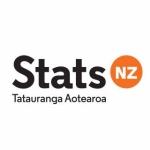Vulnerable children and families: Some findings from the New Zealand General Social Survey
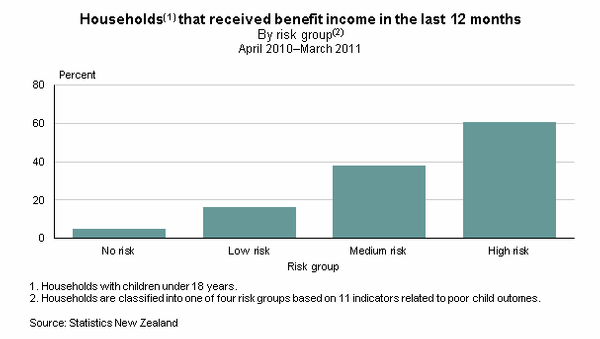
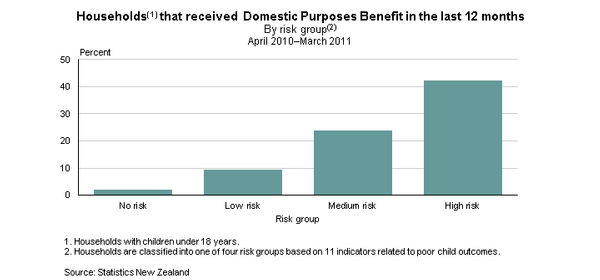
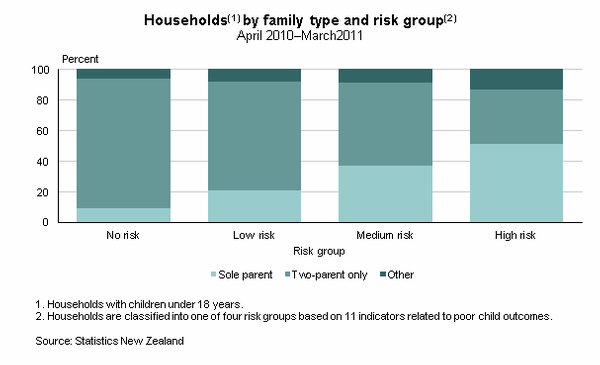
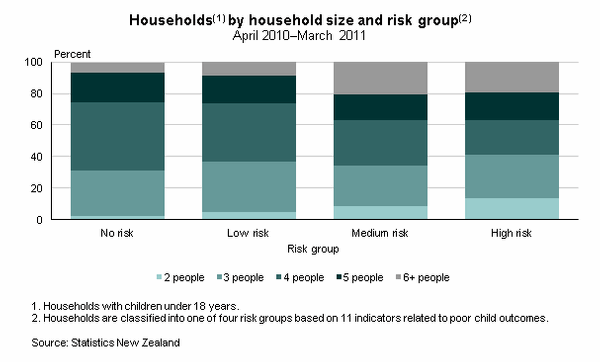
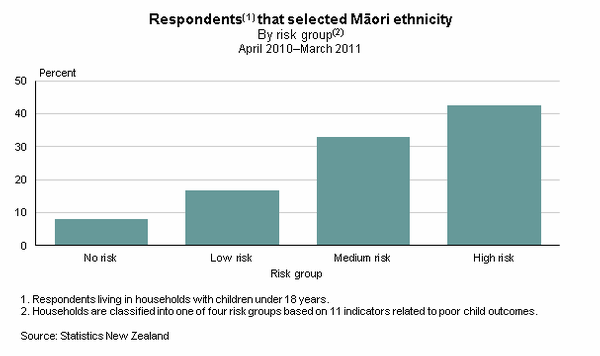
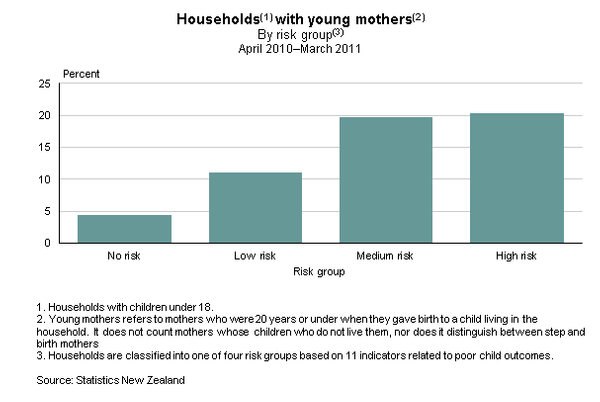
1 Purpose and summary
Purpose
Vulnerable children and families uses data from the New Zealand General Social Survey: 2010 to look at households with vulnerable children. Eleven economic, housing, health, and social indicators related to poor child outcomes were used to identify households with at-risk children. This report provides a national picture of the prevalence and characteristics of these households in New Zealand and provides context for current initiatives to support vulnerable children.
Summary of key points
The key points in this report are:
- 1 in 4 children under the age of 18 live in households defined in this report as medium or high risk, or those with three or more risk factors
- 6 percent of children live in high-risk households with five or more risk factors
- households in the high-risk group include those receiving benefit income, sole-parent households, large households, households with Māori respondents, and households where the mother had given birth to her child before the age of 21.
2 Policy context
The Government has a policy focus on supporting vulnerable children and the Expert Advisory Group on Solutions to Child Poverty has expressed concern about poor child outcomes. In The Green Paper for Vulnerable Children, the Ministry of Social Development (2011) noted that any single risk factor on its own generally only raises the risk of poor child outcomes by a modest amount, but an accumulation of risks significantly heightens the risk of poor outcomes.
The General Social Survey offers a range of economic, health, housing, neighbourhood, and social connectedness measures providing a unique cross-dimensional view of vulnerability. This report looks at multiple risks and can be used to inform discussions about vulnerable children.
3 Using the General Social Survey to identify vulnerable children
The General Social Survey (GSS) collects social and economic data on households and individuals from 8,000 New Zealanders aged 15 years and over. This report looks at the 3,086 households with children under 18 in the 2010 GSS. All figures in this report were weighted using household weights to represent the New Zealand population.
The Ministry of Social Development and Statistics NZ selected 11 risk factors contained in the GSS that are believed to adversely affect children’s development or well-being. The selected risk factors are related to health, housing, income adequacy, neighbourhood, social connections, crime, and discrimination. The measures are not exhaustive and information on other possible risk factors, such as parental drug or alcohol abuse, is not covered by the survey. As some risk factors are linked to the individual respondent, not the household as a whole, this report will understate the number of households and children at risk.
The presence of the selected risk factors among households with children ranges from 21 percent containing a respondent smoker, to 8 percent having poor physical health or limited access to facilities, as shown in table 1.
Table 1
Prevalence of risk factors in New Zealand households with children
April 2010–March 2011
| Risk factor | Percent |
| Current cigarette smoker | 21 |
| Victim of crime in last 12 months | 20 |
| Living in a high deprivation area | 20 |
| Feeling isolated some, most, or all of the time | 17 |
| Poor mental health | 15 |
| Victim of discrimination in last 12 months | 12 |
| Low economic standard of living, based on ELSI | 11 |
| More than one housing problem | 10 |
| Living in an overcrowded house | 9 |
| Limited access to facilities | 8 |
| Poor physical health | 8 |
|
Note: ELSI = economic living standard index Source: Statistics New Zealand |
|
4 Characteristics of households at risk
This chapter looks at the characteristics of households and the number of children at risk. For this report, we defined households as high risk where they have five or more risk factors present, medium risk where households have three to four risk factors, and low risk where one to two factors exist.
One in four children live in medium- to high-risk households
One in four New Zealand children (268,000) live in medium- to high-risk households. Roughly 67,000 children (6 percent) live in households defined here as high risk (those with five or more of the 11 risk factors). A further 19 percent of children (201,000) live in medium-risk households (those with three or four risk factors). Table 2 shows the number and proportion of children by risk group.
Table 2
Number and proportion of children by risk group
April 2010–March 2011
| Number of risk factors |
Number of children (aged under 18 years) |
Proportion of children (%) | |
| No risk | 0 | 328,000 | 30 |
| Low risk | 1–2 | 482,000 | 45 |
| Medium risk | 3–4 | 201,000 | 19 |
| High risk | 5+ | 67,000 | 6 |
| Source: Statistics New Zealand | |||
Three in five high-risk households received benefit income in the last 12 months
Three out of five households in the high-risk group received income from a benefit in the last 12 months. For this report, benefit income includes Unemployment, Domestic Purposes, Invalid’s, and Sickness benefits. More than two out of five high-risk households received income from the Domestic Purposes Benefit.
Figure 1 shows the proportion of households that received benefit income in the last 12 months, by risk group. Figure 2 shows the proportion of households that received domestic purposes benefit in the last 12 months, by risk group.
See Figure 1 Households that received benefit income in the last 12 months, by rish group, April 2010-March 2011.
See Figure 2 Households that received Domestic Purposes Benefit in the last 12 months, by risk group, April 2010-March 2011
Half of households in the high-risk group contain sole parents
Of households in the high-risk group, about half are sole-parent households. Two-parent-only households dominate the no-risk and low-risk groups, making up 84 percent and 71 percent of each group, respectively. Figure 3 shows the proportion of family types in each risk group.
See Figure 3 Household by family type and risk group, April 2010-March 2011
Sole parents are more likely to have low income compared with two-parent families. This is one reason sole parents are more at risk. However, family structure also plays a role. For households in the bottom two income quintiles, 58 percent of high-risk and just 25 percent of no-risk households are sole-parent households. This compares with two-parent-only households where the relationship is reversed, with 69 percent no-risk and 34 percent high-risk households.
Households with six or more people and two-person households at greater risk
Households with six or more people make up 19 percent of the high-risk group compared with 7 percent of the no-risk group. Similarly, households with two people (sole-parent households with one child) comprise 14 percent of the high-risk group and just 3 percent of the no-risk group. Figure 4 shows the proportion of households by household size in each risk group.
See Figure 4 Households by household size and risk group, April 2010-March 2011
Māori over-represented in high-risk households
Nearly 43 percent of households in the high-risk group had a Māori respondent, compared with 8 percent in the no-risk group. Figure 5 shows the proportion of respondents selecting Māori ethnicity in each risk group. The graph shows the ethnicity of the respondent, not the ethnicity of the entire household.
See Figure 5 Respondents that selected Maori ethnicity, by risk group, April 2010-March 2011
One in five mothers in the high- and medium-risk groups had their children young
Figure 6 shows 1 in 5 high-risk and medium-risk households contain a young mother, compared with 1 in 20 in the no-risk group. A young mother refers to a mother who was 20 years or under when she gave birth to a child living in the household. It does not include mothers whose children do not live with her, nor does it distinguish between step and birth mothers.
See Figure 6 Households with young mothers, by risk group, April 2010-March 2011
References
Ministry of Social Development (2011). The Green Paper for Vulnerable Children: Every child thrives, belongs, achieves. Available from www.msd.govt.nz.
Appendix 1 – Additional tables
Table 3
Proportion of households in each risk group by income and employment status
April 2010–March 2011
| No risk | Low risk | Medium risk | High risk | |
| Percent | ||||
| Household benefit income in last 12 months(1) | 5.0* | 16.3 | 38.0 | 60.7 |
| Household benefit income in last 12 months | ||||
| Domestic Purposes | 2.2* | 9.6 | 23.9 | 42.4 |
| Unemployment | 1.1** | 5.6* | 9.8* | 9.1** |
| Sickness or Invalid | 2.4** | 3.4* | 9.4* | 13.4* |
| Lowest household income quintile(2) | 8.9 | 17.8 | 33.2 | 59.3 |
| Employment status of respondent(3) | ||||
| Employed | 78.4 | 70.7 | 59.7 | 33.8 |
| Not in labour force | 19.7 | 24.7 | 29.5 | 51.4 |
| Unemployed | 1.9** | 4.6* | 9.9* | 13.9* |
|
1. Household benefit income from the Domestic Purposes (DPB), Unemployment (UB), Sickness (SB), and Invalid (IB) benefits in the last 12 months. Note the UB, DPB, SB, and IB percentages will not sum to the overall household benefit income as households may receive more than one benefit type in the last 12 months. 2. Household income has been equivalised by household size (that is, divided by the square root of the number of people in the household). Quintiles have been calculated for households with children, not the total population. The bottom equivalised quintile is $21,650. 3. Respondent employment status. As one respondent aged 15 years or over is chosen per household, this may not be the parent. Symbols: * relative sampling error 30–49.9 percent. ** relative sampling error 50 percent or more. Source: Statistics New Zealand |
||||
Table 4
Proportion of households in each risk group by demographic factors
April 2010–March 2011
| No risk | Low risk | Medium risk | High risk | |
| Percent | ||||
| Family type(1) | ||||
| Sole parent only | 7.3 | 13.1 | 24.6 | 39.6 |
| Sole parent + others | 2.1** | 7.7 | 12.2 | 11.8** |
| Two parent only | 84.3 | 71.4 | 54.5 | 35.2 |
| Other | 6.4 | 7.8 | 8.6* | 13.4* |
| Household size(2) | ||||
| Two | 2.5* | 5.0 | 8.3 | 13.7* |
| Three | 28.6 | 31.8 | 26.0 | 27.6 |
| Four | 43.0 | 37.2 | 28.7 | 22.2* |
| Five | 18.9 | 17.5 | 16.7 | 17.4* |
| Six+ | 6.7 | 8.5 | 20.4 | 19.1* |
| Number of children | ||||
| One | 39.8 | 43.7 | 37.3 | 35.9 |
| Two | 41.5 | 39.2 | 32.8 | 34.8 |
| Three | 15.0 | 13.4 | 16.4 | 14.4* |
| Four+ | 3.6* | 3.7 | 13.4 | 14.8* |
| Early motherhood(3) | 4.5* | 11.1 | 19.8 | 20.4* |
| Respondents with Māori ethnicity(4) | 7.9 | 16.8 | 32.9 | 42.6 |
| Migrant status of respondent | ||||
| Long-term migrant | 19.1 | 20.8 | 20.2 | 15.5* |
| New Zealand born | 73.3 | 71.3 | 73.1 | 78.1 |
| Short-term migrant | 7.6 | 7.9 | 6.7* | 6.4** |
| Highest qualification of respondent | ||||
| Degree | 28.6 | 20.3 | 11.4 | 8.9** |
| Levels 4–6 certificate and diplomas(5) | 23.9 | 23.5 | 21.2 | 15.5* |
| School qualification | 34.5 | 36.1 | 32.9 | 36.0 |
| No qualification | 9.6 | 15.7 | 29.8 | 30.3 |
| Not elsewhere included | 3.4* | 4.4 | 4.7* | 9.4** |
|
1. Households are broken into four types of households: a) ‘sole parents only’ living alone with their children, b) ‘sole parents + others’ living with other adults – an example would be a sole parent living with his/her parents, c) ‘two-parent only’, and d) other household types, for example, a two-parent family living with grandparents. In the body of the report, the two sole-parent groups have been combined. 2. There were two 17-year-olds living alone in the 2010 sample; these one-person households have been removed from the table. 3. Early motherhood denotes mothers who were 20 years or younger when they gave birth to their children. This is calculated by looking at the age of the mother and her children in the household. It does not count children who do not live with their mothers, nor does it distinguish between step and birth mothers. 4. Ethnicity is based on the ethnicity of the respondent – one per household. Respondents were counted if they chose Māori as one of their ethnic groups. 5. Levels 4 to 6 certificates and diplomas include trade and vocational training. Symbols: * relative sampling error 30–49.9 percent. ** relative sampling error 50 percent or more. Source: Statistics New Zealand |
||||
Table 5
Family type by risk group, for low-income households(1)
April 2010–March 2011
| Family type(2) | No risk | Low risk | Medium risk | High risk |
| Percent | ||||
| Sole parent only | 23.9 | 28.3 | 38.9 | 46.6 |
| Sole parent + others | 1.5** | 7.1 | 10.3* | 11.6** |
| Two parent only | 69.2 | 59.5 | 46.5 | 34.1 |
| Other | 5.5** | 5.2* | 4.3** | 7.7** |
|
1. Bottom two quintiles equivalised by household size. 2. Households are broken into four types of households: a) ’sole parents only’ living alone with their children, b) ‘sole parents + others’ living with other adults – an example would be a sole parent living with his/her parents, c) ‘two-parent only’, and (d) other household types, for example, a two-parent family living with grandparents. In the body of the report, the two sole-parent groups have been combined. Symbols: * relative sampling error 30–49.9 percent. ** relative sampling error 50 percent or more. Source: Statistics New Zealand |
||||
Appendix 2 – Methodological notes
This chapter describes how we derived the 11 risk factors discussed in this report. This is followed by methodological notes outlining any limitations of the data.
The 11 risk factors and how we derived them are listed below:
- low economic living standard index (ELSI) – less than or equal to 12
- living in high deprivation area – New Zealand deprivation index deciles 9 and 10
- overcrowding based on the Canadian National Occupancy Standard – household lacks one or more bedrooms
- more than one housing problem – too damp, too expensive, or too cold or difficult to heat
- limited access to facilities, such as shops, schools, post shops, libraries, and medical services
- current cigarette smoker
- poor mental health scores 0–39; severe disability = 0–29; and moderate disability = 30–39
- poor physical health scores 0–39
- isolation – feeling isolated some, most, or all of the time,
- victim of crime in last 12 months
-
victim of discrimination in last 12 months.
This report identifies risk factors in New Zealand households with children, and then categorises the households as high, medium, low, or no risk based on the number of risk factors associated with the household.
The analysis gives equal weight to each of the 11 risk factors. It does not consider certain risk factors or combination of factors that may have a greater impact on vulnerability.
This analysis combines household data (low economic living standard index, housing problems, and neighbourhoods defined by the New Zealand deprivation index as areas of high deprivation) with individual measures (poor physical health, poor mental health, feelings of isolation, smoking, victim of crime and discrimination).
The use of individual characteristics for some risk variables will undercount the existence of these risk factors because they cannot account for other individuals in the household with these characteristics. For example, the respondent’s mental health will under-represent the number of households directly affected by poor mental health as this will be flagged in cases where the respondent is affected, but not where other household members are affected. In addition, the impact of poor mental health on a household is likely to differ depending on the household role of the person with poor mental health. The net effect of categorising households based on the respondent’s characteristics will be to understate the number of children who are at risk and to overstate those who are not at risk.
An output with a relative sampling error of 30 percent to 49.9 percent should be viewed with caution (flagged in tables by an asterisk *), and an error of 50 percent or more should be considered unreliable (flagged by **).
See New Zealand General Social Survey for more details about the survey.
See New Zealand General Social Survey for details about the 2008 and 2010 surveys, and other reports and releases, available at www.stats.govt.nz/nzgss.
